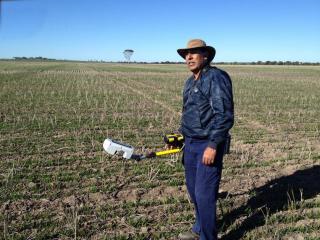Optimising oats in low rainfall areas
The opportunity to grow higher yielding, better quality oats in low rainfall areas has been given a boost with the commencement of a new oats agronomy research project.
The research is a part of the Department of Agriculture and Food’s Tactical Break Crop Agronomy project, backed by the Grains Research and Development Corporation.
There has been renewed interest in growing oats, with higher world prices driving increased plantings, which resulted in a record 540,000 tonne Western Australian harvest in 2013.
Despite this interest, DAFWA research officer Raj Malik said many growers in low rainfall areas are still planting varieties that are 30 years old, which are not milling grade and do not meet export hay requirements.
“At field day at Holt Rock last year growers expressed interest in sowing the newer, higher value oats varieties but there is very little agronomic information about growing these varieties in low rainfall areas,” Dr Malik said.
“Our aim for this project is to develop agronomic and management packages tailored to low rainfall areas to assist growers to improve oat production and profitability.”
Four oats varieties, Bannister, Carrolup, Williams and Yallara, and two new lines were planted in late May at Holt Rock, Cunderdin and at DAFWA’s Merredin Research Station.
This year the trial will examine sowing rates and responses to nitrogen fertiliser, while other agronomic issues, such as time of sowing, will be included in the future research.
Dr Malik said the oat varieties in the trial were sown at varied rates to achieve the target plant density due to variation in their grain weights.
“Seeding rates of 80, 130 and 170 kilograms per hectare were used to achieve target densities of 160, 240 and 320 plants per metre square, respectively, with a typical average grain weight of 40 milligrams to achieve a 75-80 per cent establishment rate,” he said.
“Assessing the impact of varied seeding rates on grain and hay quality will assist growers who have sown for grain but end up harvesting for hay – or vice-versa – due to a change in the season or market circumstances.”
The response of each oats variety to the nitrogen applications will also be examined.
Fertiliser was put out in late June/early July at rates of nil, 20 and 80 kilograms of nitrogen per hectare, extending the traditional rate of 20-30kgN/ha.
“We are particularly interested in the interaction between nitrogen and sowing rates and its impact of grain and hay yield and quality,” Dr Malik said.
An economic analysis will be undertaken on each component or the research.
The grain quality will be extensively measured for hectolitre weight, average grain weight, screenings, colour and protein, while the hay quality will be measured for colour, crude protein, water soluble carbohydrates, metabolisable energy, fibre content (ADF and NDF) and invitro digestibility.
“Ultimately this information will provide growers and consultants with suitable management strategies to optimise their oat crop’s potential and profitability in low rainfall areas,” Dr Malik said.
For more information about this and other DAFWA grains research projects, tools and information visit agric.wa.gov.au and watch local media for details of spring field walks.

Media contact: Jodie Thomson/Megan Broad, media liaison +61 (0)8 9368 3937
